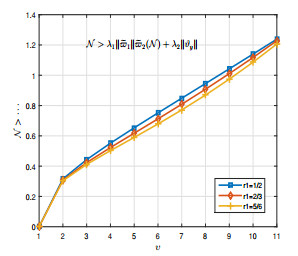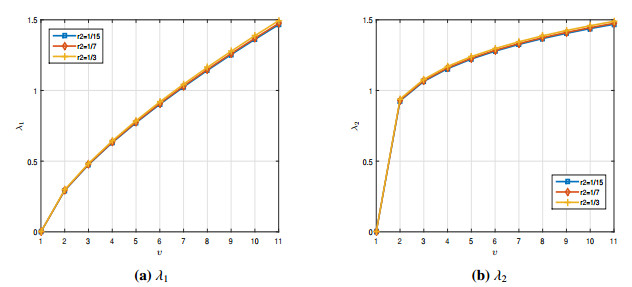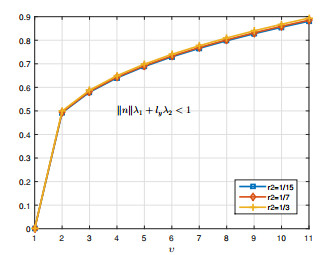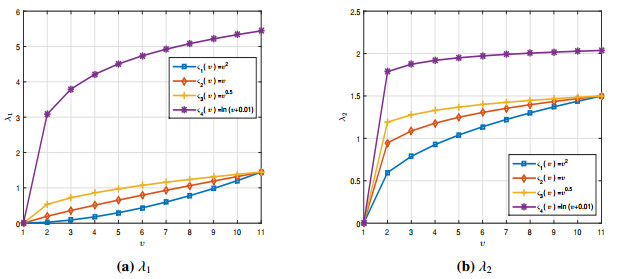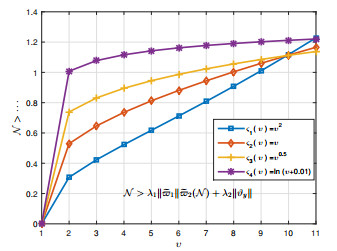1.
Introduction
Fractional differential inclusions (FDIs), as an extension of fractional differential equations (FDEs), have gained popularity among mathematical researchers due to their importance and value in optimization and stochastic processes in economics [1,2] and finance [3]. In addition to their applications in understanding engineering [4] and dynamic systems [5,6] in biological [7,8], medical [9], physics [10] and chemical sciences [11], FDIs are also relevant in various other scientific fields [12].
Sousa and Oliveira [13] introduced the new fractional derivative ς-Hilfer to unify different types of fractional derivatives into a single operator, expanding fractional derivatives to the types of operators with potentially applicable value. After that, Asawasamrit et al. [14] investigated the following Hilfer-FDE under nonlocal integral boundary conditions (BCs):
In [15], an existence outcome was shown by employing the FPTs (fixed-point theorems) for a sequential FDE of the type,
where ri∈(0,1), i=1,2,3, r4=r1+r2(1−r1), r4+r3>1, η1,η2∈R, r5>0, and ℷ∈C(B×R3) is a nonlinear function. In 2024, Ahmed et al. [16] investigated a class of separated boundary value problems of the form
where 0<r1,r3<1, r2∈[0,1] with r4=r1+r2(1−r1), r3+r4>1 and ℷ∈C(B×R). Lachouri et al., in [17], established the existence of solutions to the nonlinear neutral FDI involving ς-Caputo fractional derivative with ς-Riemann–Liouville (RL) fractional integral boundary conditions:
where ℷ:B×R→P(R) is a set-valued map. Surang et al., in [18], studied the ς-Hilfer type sequential FDEs and FDIs subject to integral multi-point BCs of the form
where r1∈(1,2), r2∈[0,1], ℷ∈C(℧×R), k,μi,θj∈R, and ηi,ξj∈(˜s,˜b], i=¯1,n, j=¯1,m. Etemad et al. [19] introduced and studied a novel existence technique based on some special set-valued maps (SVMs) to guarantee the existence of a solution for the following fractional jerk inclusion problem involving the derivative operator in the sense of Caputo–Hadamard
for υ∈[1,exp(1)], where ri∈(0,1], i=1,2,3, η∈(1,exp(1)), and the operator ℷ:[1,exp(1)]×R3→P(R) is an SVM, where P(R) denotes all nonempty subsets of R.
The boundary conditions (BCs) used in (1.1) and (1.2), share a common feature: the requirement of a zero initial condition, which is essential for the solution to be well-defined. Consequently, certain classes of Hilfer FDEs cannot be addressed, including cases with BCs such as,
● ϰ(0)=−ϰ(˜b), ϰ′(0)=−ϰ′(˜b) (anti-periodic),
● ϰ(0)+η1ϰ′(0)=0, ϰ(˜b)+η2ϰ′(˜b)=0 (separated),
● ϰ(0)+η1ϰ(˜b)=0, ϰ′(0)+η2ϰ′(˜b)=0 (non-separated), etc.
To address this limitation and study Hilfer FDEs with such BCs, regardless of whether they are anti-periodic, separated, or non-separated, we propose a novel approach in this research. Specifically, we combine the Hilfer and Caputo fractional derivatives, enabling the study of boundary value problems under these conditions. More specifically, we aimed to analyze a class of FDEs for FDI, subject to non-separated BCs of the form,
where ri∈(0,1), i=1,2,3, δ=r1+r2(1−r1), δ+r3>1, η1,η2∈R, y∈C(B×R) and ℷ:B×R→P(R) denotes a SVM, with power set P(R) of R.
The paper is structured as follows. Section 2 is devoted to discussing the fundamental concepts fractional calculus and set-valued analysis, while Section 3 presents important findings on the qualitative properties of solutions to the ς-Hilfer inclusion FDI (1.3) utilizing FPTs. Finally, Section 4, includes three illustrative examples.
2.
Background concepts
2.1. Fractional calculus
We outline the background material that is pertinent to our study. We consider the Banach spaces E=C(B) and L1(B) of the Lebesgue integrable functions equipped with the norms ‖ϰ‖=sup{|ϰ(υ)|:υ∈B} and
respectively. Let ς∈Cn(B) be an increasing function such that ς′(υ)≠0, for any υ∈B.
Definition 2.1 ([20]). The ς-RL fractional integral and derivative of order r1 for a given function ϰ are expressed by
and
where n=[r1]+1, n∈N, respectively.
Definition 2.2 ([21,22]). The Caputo sense of ς-fractional derivative of the ϰ∈Cn(B) of order r1 is given as,
Lemma 2.3 ([20,22]). Let r1,r2>0. Then
Lemma 2.4 ([20]). For ϰ∈Cn(B), we have
and 0<r2<1. Furthermore, if r1∈(0,1), then RLIr1,ςCDr1,ς ϰ(υ)=ς0(υ).
Definition 2.5 ([13]). The ς-Hilfer fractional derivative for ϰ∈Cn(B), of order n−1<r1<n and type 0≤r2≤1, is defined by
Lemma 2.6 ([13,23]). Let r1,r2,μ>0. Then
Lemma 2.7 ([13]). For μ>0, r1∈(n−1,n), and 0≤r2≤1,
In particular, if r1∈(1,2) and 1<μ≤2, then HDr1,r2,ς(ς0(υ))μ−1=0.
Lemma 2.8 ([13]). If ϰ∈Cn(B), n−1<r1<n and type 0<r2<1, then
2.2. Auxiliary notions of set-valued maps
Consider the Banach space (E,‖⋅‖) and SVM Θ:E→P(E). Θ is a) closed (convex), b) bounded and c) measurable, whenever Θ(ϰ) is closed (convex) for every ϰ∈E, Θ(B)=∪ϰ∈BΘ(ϰ) is bounded for any bounded set B⊆E, that is
and ∀ρ∈R, the function
is measurable, respectively. One can find the definitions of completely continuous and upper semi-continuous in [24]. Additionally, the set of selections of ℷ is described as
Next, we take
where Pcl, Pc, Pb, and Pcp represent the classes of every compact, bounded, closed, and convex subset of E, respectively.
Definition 2.9 ([25]). An SVM ℷ:B×R→P(R) is called Carathéodory if the mapping υ→ℷ(υ,ϰ) is measurable for all ϰ∈R, and ϰ→ℷ(υ,ϰ) is upper semicontinuous for almost every υ∈B. Additionally, we say ℷ is L1-Carathéodory whenever for all m>0, exists z∈L1(B,R+) such that for a.e. υ∈B,
To achieve the intended outcomes in this search, the following lemmas are necessary.
Lemma 2.10 ([25], Proposition 1.2). Consider SVM Θ:E→Pcl(Z) with the graph, Gr(Θ)={(ϰ,ρ)∈E×Z:ρ∈Θ(ϰ)}. Gr(Θ) is a closed subset of E×Z whenever Θ is upper semi-continuous. Conversely, Θ is upper semi-continuous, when it has a closed graph and is completely continuous.
Lemma 2.11 ([26]). Consider a separable Banach space E along with a L1-Carathéodory SVM ℷ:B×R→Pcp,c(E) and a linear continuous map Υ:L1(B,E)→C(B,E). Then, the composition
is a closed graph map in C(B,E)×C(B,E).
3.
Existence results for fractional differential inclusion (1.3)
In relation to the FDI (1.3), the auxiliary Lemma 3.1 is required.
Lemma 3.1. For y,ℷ∈C(B), the solution of linear-type problem
is obtained as follows:
where for η1,η2≠−1,
Proof. Applying the ς-fractional integral RLIr1,ς to the first equation of (1.3), and using Lemma 2.4, we get
where δ=r1+r2(1−r1). Now, by taking RLIr3,ς in (3.4) from Lemma 2.3, we get
According to Lemma 2.3, we can obtain
Next, by combining the BCs ϰ(0)+η1ϰ(˜b)=0 and
with (3.6), we get
From (3.7) and (3.8), we find
By substituting the values of c1 and c2 into (3.5), we arrive at the fractional integral equation (3.2). □
Definition 3.2. An element ϰ∈C1(B) can be a solution of (1.3), if there is σ∈L1(B) with σ(υ)∈ℷ(υ,ϰ) for every υ∈B fulfilling the non-separated BC's, ϰ(0)+η1ϰ(˜b)=0,
and
3.1. The upper semi-continuous case
The first consequence addresses the convex-valued ℷ using the nonlinear alternative for contractive maps [27].
Theorem 3.3. Suppose that
P1) ℷ:B×R→Pcp,c(R) is a L1-Carathéodory SVM;
P2) There is a exist ˜ϖ1∈C(B,R+) and a nondecreasing ˜ϖ2∈C(R+,R+) with,
P3) There is a constant ly<λ−12 such that |y(υ,ϰ1)−y(υ,ϰ2)|≤ly|ϰ1−ϰ2|;
P4) There is a exist ϑy∈C(B,R+) such that |y(υ,ϰ)|≤ϑy(υ), for each (υ,ϰ)∈B×R;
P5) There is an N>0 satisfying
where
Then, (1.3) admits a solution of B.
Proof. At first, to convert the sequential-type FDI (1.3) into a problem of the FP type, we write Θ:E→P(E) as follows:
for σ∈Rℷ,ϰ. Consider two operators Ψ1:E→E and Ψ2:E→P(E) as follows:
and
Obviously, Θ=Ψ1+Ψ2. In the following, we demonstrate that Ψ1 and Ψ2 fulfill the conditions of the nonlinear alternative for contractive maps [27, Corollary 3.8]. Initially, we consider the set,
which is bounded, and show that Ψ˚ȷ define the SVMs Ψ˚ȷ:Ωγ∗→Pcp,c(E), ˚ȷ=1,2. To achieve this, we need to prove that Ψ1 and Ψ2 are compact and convex-valued. The proof will proceed in five steps.
Step 1. Ψ2 is bounded on bounded sets of E. Let Ωγ∗ be a bounded set in E. Then for every z∈Ψ2(ϰ) and ϰ∈Ωγ∗, σ∈Rℷ,ϰ exists such that,
Let (P1) holds. For any υ∈B, we obtain,
Indeed, ‖z‖≤λ1‖˜ϖ1‖˜ϖ2(γ∗).
Step 2. Ψ2 maps bounded sets of E into equicontinuous sets. Let ϰ∈Ωγ∗ and z∈Ψ2(ϰ). In this case, an element σ∈Rℷ,ϰ exists such that
Let υ1,υ2∈B, υ1<υ2. Then
As υ1→υ2, we obtain, |z(υ2)−z(υ1)|→0. Therefore, Ψ2(Ωγ∗) is equicontinuous. Combining the results from Steps 1 and 2, and employing the theorem of Arzelà-Ascoli, we can confirm the completely continuity of Ψ2.
Step 3. Ψ2(ϰ) is convex for all ϰ∈E. Let z1,z2∈Ψ2(ϰ). Then σ1,σ2∈Rℷ,ϰ exist such that for each υ∈B
Let μ∈[0,1]. Then for any υ∈B,
Since ℷ has convex values, Rℷ,ϰ is convex, and for μ∈[0,1], (μσ1(υ)+(1−μ)σ2(υ))∈Rℷ,ϰ. Therefore, μz1(υ)+(1−μ)z2(υ)∈Ψ2(ϰ), which shows that Ψ2 is convex-valued. Moreover, Ψ1 is compact and convex-valued.
Step 4. We prove that Gr(Ψ2) is closed. Let ϰn→ϰ∗, zn∈Ψ2(ϰn) and zn→z∗. We show that z∗∈Ψ2(ϰ∗). Since zn∈Ψ2(ϰn), there is a σn∈Rℷ,ϰn such that,
Therefore, we need to prove the existence of σ∗∈Rℷ,ϰ∗ such that for each υ∈B,
Let Υ:L1(B,R)→C(B,R) be a continuous linear operator defined as follows:
Notice that
when n→∞. Therefore, by Lemma 2.11, Υ∘Rℷ,ϰ is a closed graph operator. Additionally, zn∈Υ(Rℷ,ϰn). Since ϰn→ϰ∗, Lemma 2.11 gives
for some σ∗∈Rℷ,ϰ∗. Thus, the graph of Ψ2 is closed. As a result, Ψ2 is compact and upper semi-continuous.
Step 5. We prove that Ψ1 is a contraction in E. Let ϰ1,ϰ2∈E. By using the assumption (P3), we get,
Thus, ‖Ψ1ϰ1−Ψ1ϰ2‖≤lyλ2‖φ−¯φ‖. As lyλ2<1, we conclude that Ψ1 is a contraction. Thus, the operators Ψ1 and Ψ2 meet the theorem [27] hypotheses. As a result, we conclude that either of the two following conditions holds, (a) Θ has an FP in ¯E, (b) we have ϰ∈∂E and ξ∈(0,1) with ϰ∈ξF(ϰ). We show that conclusion (b) is not possible. If ϰ∈ξΨ1(ϰ)+ξΨ2(ϰ) for ξ∈(0,1). Then, σ∈Rℷ,ϰ exists such that
which implies that |ϰ(υ)|≤λ1‖˜ϖ1‖˜ϖ2(ϰ)+λ2‖ϑy‖, for each υ∈B. If criterion of [27, Theorem-(b)] is true, then ξ∈(0,1) and ϰ∈∂E with ϰ=ξΘ(ϰ) exist. Therefore, ϰ is a solution of (1.3) with ‖ϰ‖=N. Now, thanks to |ϰ(υ)|≤λ1‖˜ϖ1‖˜ϖ2(ϰ)+λ2‖ϑy‖, we get
which contradicts (3.10). Thus, it follows from the theorem [27] that Θ admits an FP, and it is a solution of (1.3).
□
3.2. The Lipschitz case
We try to establish a more general existence criterion for the FDI (1.3) under new hypotheses. Specifically, we demonstrate the desired existence result for a nonconvex-valued right-hand side using the theorem of Covitz and Nadler [28]. For a metric space (E,ϱ), we define
where ϱ(˜R1,˜r2)=inf˜r1∈˜R1ϱ(˜r1,ϱ2) and ϱ(˜r1,˜R2)=inf˜r2∈˜R2ϱ(˜r1,˜r2). Then (Pb,cl(E),Hϱ) forms a metric space [29].
Definition 3.4. An SVM Ω:E→Pcl(E) is a ˜η-Lipschitz if and only if ˜η>0 exists such that
In particular, Ω is a contraction whenever ˜η<1.
Theorem 3.5. Assume that (P3) and the following conditions hold:
P6) The map ℷ:B×R→Pcp(R) is such that ℷ(⋅,φ):B→Pcp(R) is measurable for any ϰ∈R;
P7) The condition Hϱ(ℷ(υ,ϰ1),ℷ(υ,ϰ2))≤n(υ)|ϰ1−ϰ2| holds for a.e. υ∈B and ϰ1,ϰ2∈R with n∈C(B,R+) and ϱ(0,ℷ(υ,0))≤n(υ) for a.e. υ∈B.
Then FDI (1.3) has at least one solution for B whenever ‖n‖λ1+lyλ2<1, where λ1,λ2 are given in (3.11).
Proof. By assumption (P6) and [30, Theorem III.6], ℷ has a measurable selection σ:B→R, with σ∈L1(B), which implies that ℷ is integrability bounded. Therefore, Rℷ,ϰ≠∅. We demonstrate that the operator Ω:E→P(E) described in (3.12) meets the conditions required by Nadler and Covitz's FPT. Specifically, we prove that Ω(ϰ) is closed for each ϰ∈E. Assume a sequence such that {un}n≥0∈Ω(ϰ) and un→u(n→∞) in E. Then u∈E and σn∈RG,ϰn exists such that
So there is a subsequence σn that converges to σ in L1(B), because ℷ has compact values. As a result, σ∈Rℷ,ϰ, and we get
Hence u∈Ω(ϰ). Next, we show that a Δ∈(0,1), (Δ=‖n‖λ1+lyλ2) exists such that
Let ϰ1,ϰ2∈E and v1∈Ω(ϰ1). Then σ1(υ)∈ℷ(υ,ϰ1(υ)) exists such that for all υ∈B and
By (P7), we have
Thus, χ(υ)∈ℷ(υ,ϰ2) exists such that |σ1(υ)−χ|≤n(υ)|ϰ1(υ)−ϰ2(υ)|, for each υ∈B. We build an SVM, O:B→P(R) as follows:
Notice that σ1 and ω=n|ϰ1−ϰ2| are measurable, so it follows that O(υ)∩ℷ(υ,ϰ2) is measurable. Next, we select the function σ2(υ)∈ℷ(υ,ϰ2) such that,
Define
As a results, we arrive at,
which implies ‖v1−v2‖≤(‖n‖λ1+lyλ2)‖ϰ1−ϰ2‖. Now, by interchanging the roles of ϰ1 and ϰ2, we obtain,
Since Ω is a contraction, it follows that the Covitz and Nadler theorem that Ω has an FP, which is a solution of the FDI (1.3).
□
4.
Examples
In order to validate the theoretical findings, we provide specific cases of FDIs in this section. In fact, we focus on the FDI with the following form:
The examples below are special cases of FDIs given by (4.1).
Example 4.1. Using the FDIs defined by (4.1) and taking r1∈{12,23,56}, r2=13, r3=15, ς(υ)=υ2, η1=14, η2=16, δ=0.666,0.777,0.888, and ˜b=1, the problem (4.1) is reduced to
for υ∈B. With these data, it follows from (3.3), that we have
We define the function y and the SVM ℷ:B×R→P(R) as follows:
and
For ϰ,¯ϰ∈R, we have
with ly=12 and also,
Thus, the assumptions (P3) and (P4) hold. It is also clear that the SVM ℷ satisfies the assumption (P1) and
where ‖˜ϖ1‖=14 and ˜ϖ2(‖ϰ‖)=1. Thus, (P2) holds, and by (P5),
for which the curves are shown in Figure 1, Moreover,
whenever N=1.15, which it is shown in Figure 2. As seen in Table 1, the effect of the order of the derivative r1 is very insignificant. So all assumptions of Theorem 3.3 are valid. Hence the FDI (4.2) has a solution for B.
In the next example, we check the changes in the derivative order r2.
Example 4.2. Using the FDI defined by (4.1) and taking r1=12, r2∈{115,17,13}, r3=15, ς(υ)=υ, η1=14, η2=16, δ=0.533,0.571,0.666, and ˜b=1, 4.1 is reduced to
With these data, we find
Consider the SVM ℷ:B×R→P(R) is defined by, φ→ℷ(υ,ϰ)=[0,sin(ϰ)5√υ2+4+112], and the function y defined in (4.3). From (4.5), we see that the assumption (P3) is satisfied with ly=12. Next, we have Hϱ(ℷ(υ,ϰ),ℷ(υ,¯ϰ))≤n(υ)|ϰ−¯ϰ|, where n(υ)=15√υ2+4 and ϱ(0,ℷ(υ,0))=112≤n(υ) for a.e. υ∈B. Figure 3 shows the curves of λi, i=1,2, whenever r2 varies in the interval B. By comparing the curves and data in Table 2, it can be clearly seen that as r2 approaches zero, λi decreases.
Furthermore, we obtain ‖n‖=110, resulting in
These results are shown in Table 2. Furthermore, the curves of Eq (4.7) for three cases of r2 are shown in Figure 4.
Therefore, all the assumptions of Theorem 3.5 are satisfied, which implies that at least one solution to the problem (4.6) for B.
In Example 4.3, we examine our proven theorems for changes of function ς(υ).
Example 4.3. Using the FDIs defined by (4.1) and taking r1∈23, r2=13, r3=15,
η1=14, η2=16, δ=0.777, ˜b=1, the problem (4.1) is reduced to
for υ∈B. With these data, it follows from (3.3) that
We define the function y and the SVM ℷ:B×R→P(R) as follows:
and
For ϰ,¯ϰ∈R, we have
with ly=12, as well as y(υ,ϰ)≤1exp(υ2)+1=ϑy(υ), for each (υ,ϰ)∈B×R. Thus, the assumptions (P3) and (P4) hold. It is also clear that the SVM ℷ satisfies the assumption (P1) and
where ‖˜ϖ1‖=14 and ˜ϖ2(‖ϰ‖)=1. Thus, (P2) holds, and by (P5)
for which the curves are shown in Figure 5. Moreover
whenever N=1.15, which is shown in Figure 6. As seen in Table 3, the effect of ς(υ) is very remarkable.
So all the assumptions of Theorem 3.3 are valid. Hence the FDI (4.9) has a solution for B.
5.
Conclusions
In the investigation of FDEs and FDIs that contain Hilfer fractional derivative operators, a zero initial condition is typically required. To address this limitation, we proposed a novel approach that combines Hilfer and Caputo fractional derivatives. In this research, we applied this method to study a class of FDEs for FDIs with non-separated BCs, incorporating both Hilfer and Caputo fractional derivative operators. The existence results are established by examining cases where the set-valued map has either convex or nonconvex values. For convex SVMs, the Leray-Schauder FPT was applied, whereas Nadler's and Covitz's FPTs are used for nonconvex SVMs. The findings are well demonstrated with two relevant illustrative examples. The findings of this study contribute significantly to the emerging field of FDIs. In future work, we aim to apply this method to study other types of FDEs with nonzero initial conditions, as well as coupled systems of FDEs that incorporate both Hilfer and Caputo FDs.
Availability of data and material
Data sharing not applicable to this article as no datasets were generated or analyzed during the current study.
Author contributions
Adel Lachouri: Actualization, methodology, formal analysis, validation, investigation, initial draft and a major contribution to writing the manuscript. Naas Adjimi: Actualization, methodology, formal analysis, validation, investigation and review. Mohammad Esmael Samei: Actualization, methodology, formal analysis, validation, investigation, software, simulation, review and a major contribution to writing the manuscript. Manuel De la Sen: Validation, review, funding. All authors read and approved the final manuscript.
Use of Generative-AI tools declaration
The authors declare they have not used Artificial Intelligence (AI) tools in the creation of this article.
Acknowledgments
This research was funded by the Basque Government, Grant IT1555-22.
Conflict of interest
The authors declare that they have no competing interests.
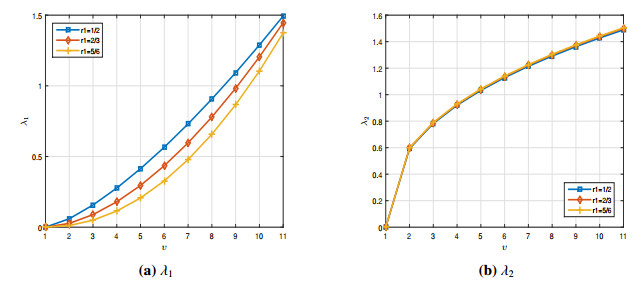









 DownLoad:
DownLoad:
